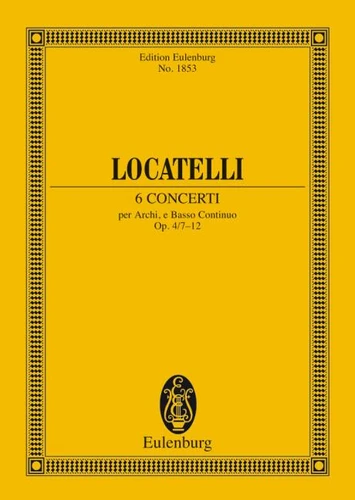Eulenburg Miniature Scores Vol. 2
6 Concerti. Vol. 2. op. 4/7 - 12. strings and basso continuo. Partition d'étude.
Par : Formats :
Actuellement indisponible
Cet article est actuellement indisponible, il ne peut pas être commandé sur notre site pour le moment. Nous vous invitons à vous inscrire à l'alerte disponibilité, vous recevrez un e-mail dès que cet ouvrage sera à nouveau disponible.
- Nombre de pages178
- Poids0.199 kg
- Dimensions13,5 cm × 19,0 cm × 0,0 cm
- ISBN978-3-7957-6464-7
- EAN9783795764647
- Date de parution01/01/2008
- CollectionPOCHE
- ÉditeurSCHOTT
- EditeurLivia Pancino
Résumé
For the six concertos that make up the second part of the Op. 4, Locatelli prescribed eight parts : Violino Primo, Secondo, Alto, è Violoncello, Soli. Violino Primo, Secondo, Alto, è Basso, Ripieni. The use of such forces immediately reminds one of the Corellian concerto grosso, to which Locatelli contributed also in his Op. 1, 7 and 9. But though the instrumentation used in this set seems to feature a clear opposition between the concertino (with solo parts) and the ripieno (with parts that can be doubled), we here encounter a group of works that are very varied in form, instrumentation and structure.
Taken as a whole the concertos of the Op. 4 ideally exemplify the developments of Italian Baroque instrumental music : they reveal the close kinship between the concerto grosso and the sonata (as in Concerto X) ; they also show the derivation of the solo concerto from the concerto grosso ; and there are even hints of thematic development and tripartite structures. Also featured are dynamic markings and other performing indications that were rare for the period and show increasing attention to the precise definition of sonorities.
Instrumentation : strings and basso continuo op. 4/7-12
Taken as a whole the concertos of the Op. 4 ideally exemplify the developments of Italian Baroque instrumental music : they reveal the close kinship between the concerto grosso and the sonata (as in Concerto X) ; they also show the derivation of the solo concerto from the concerto grosso ; and there are even hints of thematic development and tripartite structures. Also featured are dynamic markings and other performing indications that were rare for the period and show increasing attention to the precise definition of sonorities.
Instrumentation : strings and basso continuo op. 4/7-12
For the six concertos that make up the second part of the Op. 4, Locatelli prescribed eight parts : Violino Primo, Secondo, Alto, è Violoncello, Soli. Violino Primo, Secondo, Alto, è Basso, Ripieni. The use of such forces immediately reminds one of the Corellian concerto grosso, to which Locatelli contributed also in his Op. 1, 7 and 9. But though the instrumentation used in this set seems to feature a clear opposition between the concertino (with solo parts) and the ripieno (with parts that can be doubled), we here encounter a group of works that are very varied in form, instrumentation and structure.
Taken as a whole the concertos of the Op. 4 ideally exemplify the developments of Italian Baroque instrumental music : they reveal the close kinship between the concerto grosso and the sonata (as in Concerto X) ; they also show the derivation of the solo concerto from the concerto grosso ; and there are even hints of thematic development and tripartite structures. Also featured are dynamic markings and other performing indications that were rare for the period and show increasing attention to the precise definition of sonorities.
Instrumentation : strings and basso continuo op. 4/7-12
Taken as a whole the concertos of the Op. 4 ideally exemplify the developments of Italian Baroque instrumental music : they reveal the close kinship between the concerto grosso and the sonata (as in Concerto X) ; they also show the derivation of the solo concerto from the concerto grosso ; and there are even hints of thematic development and tripartite structures. Also featured are dynamic markings and other performing indications that were rare for the period and show increasing attention to the precise definition of sonorities.
Instrumentation : strings and basso continuo op. 4/7-12



